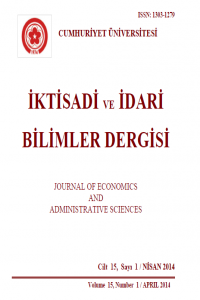Abstract
Türkiye başarılı kamu politikası modeliyle 2002 yılından itibaren istikrarlı büyüme performansını yakalamış, orta gelirli ülkeler grubunda üst sıralara ulaşmıştır. 1923 yılından 1980’lerin başlarına kadar Türkiye’de sanayileşme ve özel sermaye birikimi devletin önderliğinde gerçekleşmiştir. Türkiye 1980’lerin başlarından itibaren uygulanan liberalleşme politikalarıyla aşırı düzenlenmiş ve içe dönük ekonomisini dünya piyasalarıyla entegre etmeyi başarabilmiştir. Dışa açılmasıyla birlikte Türkiye artık nitelikli sanayi malları üreten ve ihraç eden bir ülke konumuna gelmiştir. Bu çalışmada Türk kamu politikası modelinin nasıl doğduğu ve geliştiği anlatılacaktır. Ayrıca, bu çalışmada dünyada başarılı kabul edilen kamu politikası modellerinden örnekler verilecek, bu modeller ışığında Türkiye’de kamu politikası modelinin tarihsel gelişimi anlatılacaktır.
References
- ÇAKMAK, Diren (2011), Osmanlı İktisat Düşüncesinin Evrimi, Sena Ofset Ambalaj Matbaacılık, 1. Baskı
- DOBBIN, Frank (2001), “Why the Economy Reflects the Polity: Early Rail Policy in Britain, France and the United States”, edi. Swedberg, R., Granovetter, M., The Sociology of Economic Life, 401-424, Westview Press.
- GRANOVETTER, Mark (2001), “Coase Revisited: Business Groups in the Modern Economy”, edi. Swedberg, R., Granovetter, M., The Sociology of Economic Life, 327-356, Westview Press.
- HASS, Jeff (2007), Economic Sociology: An Introduction, Routledge.
- HERMANN-PILLATH, Carsten (2007), “Adam Smith and Confucius: Towards a Transcultural Foundation of Institutions”, Fudan Journal of the Humanities and Social Sciences, 3(3), 91-126, 2010 (Erişim için SSRN: http://ssrn.com/abstract=966033).
- KEPENEK, Yakup ve YENTÜRK, Nurhan (2008), Türkiye Ekonomisi, Remzi Kitapevi, 21. Baskı.
- KEPENEK, Yakup (2011), Development and Structure of the Turkish Economy, ODTÜ Geliştirme Vakfı Yayıncılık ve İletişim AŞ, 1. Baskı.
- SAXENIAN, AnnaLee (2001), “Inside-Out: Regional Networks and Industrial Adaptation in Silicon Valley and Route 128”, edi. Swedberg, R. ve Granovetter, M., The Sociology of Economic Life, 51-76, Westview Press. SAYAR, Ahmet Güner (1998), Bir İktisatçının Entellektüel Portresi: Sabri F. Ülgener, Eren Yayıncılık
- ŞENOĞLU, Kemal (2009), Yusuf Akçura: Kemalizmin İdeoloğu, Kaynak Yayınları, 1. Baskı
- ŞİMŞEK, Osman (2008),Türk Girişimciliğinin Sosyolojisi, Öncü Basımevi,1. Baskı
- TOPRAK, Zafer (2012), Türkiye’de Milli İktisat: 1908-1918,Doğan Kitap, 1. Baskı
- TÜRKDOĞAN, Orhan (2004), Osmanlı’dan Günümüze: Türk Toplum Yapısı, Çamlıca Yayınları.
- TÜRKDOĞAN, Orhan (2005), İslami Değerler Sistemi ve Max Weber, IQ Kültür ve Sanat Yayınları.
- VOGEL, Steven K. (2007), Japan Remodeled, Cornell University Press.
Abstract
Turkey with its successful public policy model reaches a steady growth performance and achieve top positions in the middele-income countries group. From 1923 until the early 1980s industrialization and private capital accumulation in Turkey took place under the leadership of the state. With liberalization policies implemented in the early 1980s, Turkey was able to integrate over-regulated and inward-looking economy to the world markets. With the opening of the economy, Turkey becomes the producer and exporter of qualified industrial goods. The aim of this study is to explain how the Turkish public policy model is borned and developed. In this study, examples of successful public policy models in the world economy will be given and in the light of these models the historical development of Turkish model will be explained.
References
- ÇAKMAK, Diren (2011), Osmanlı İktisat Düşüncesinin Evrimi, Sena Ofset Ambalaj Matbaacılık, 1. Baskı
- DOBBIN, Frank (2001), “Why the Economy Reflects the Polity: Early Rail Policy in Britain, France and the United States”, edi. Swedberg, R., Granovetter, M., The Sociology of Economic Life, 401-424, Westview Press.
- GRANOVETTER, Mark (2001), “Coase Revisited: Business Groups in the Modern Economy”, edi. Swedberg, R., Granovetter, M., The Sociology of Economic Life, 327-356, Westview Press.
- HASS, Jeff (2007), Economic Sociology: An Introduction, Routledge.
- HERMANN-PILLATH, Carsten (2007), “Adam Smith and Confucius: Towards a Transcultural Foundation of Institutions”, Fudan Journal of the Humanities and Social Sciences, 3(3), 91-126, 2010 (Erişim için SSRN: http://ssrn.com/abstract=966033).
- KEPENEK, Yakup ve YENTÜRK, Nurhan (2008), Türkiye Ekonomisi, Remzi Kitapevi, 21. Baskı.
- KEPENEK, Yakup (2011), Development and Structure of the Turkish Economy, ODTÜ Geliştirme Vakfı Yayıncılık ve İletişim AŞ, 1. Baskı.
- SAXENIAN, AnnaLee (2001), “Inside-Out: Regional Networks and Industrial Adaptation in Silicon Valley and Route 128”, edi. Swedberg, R. ve Granovetter, M., The Sociology of Economic Life, 51-76, Westview Press. SAYAR, Ahmet Güner (1998), Bir İktisatçının Entellektüel Portresi: Sabri F. Ülgener, Eren Yayıncılık
- ŞENOĞLU, Kemal (2009), Yusuf Akçura: Kemalizmin İdeoloğu, Kaynak Yayınları, 1. Baskı
- ŞİMŞEK, Osman (2008),Türk Girişimciliğinin Sosyolojisi, Öncü Basımevi,1. Baskı
- TOPRAK, Zafer (2012), Türkiye’de Milli İktisat: 1908-1918,Doğan Kitap, 1. Baskı
- TÜRKDOĞAN, Orhan (2004), Osmanlı’dan Günümüze: Türk Toplum Yapısı, Çamlıca Yayınları.
- TÜRKDOĞAN, Orhan (2005), İslami Değerler Sistemi ve Max Weber, IQ Kültür ve Sanat Yayınları.
- VOGEL, Steven K. (2007), Japan Remodeled, Cornell University Press.
Details
| Primary Language | Turkish |
|---|---|
| Authors | |
| Publication Date | April 25, 2014 |
| Submission Date | September 9, 2013 |
| Published in Issue | Year 2014 Volume: 15 Issue: 1 |
Cumhuriyet University Journal of Economics and Administrative Sciences is licensed under a Creative Commons Attribution-NonCommercial 4.0 International License (CC BY NC).

